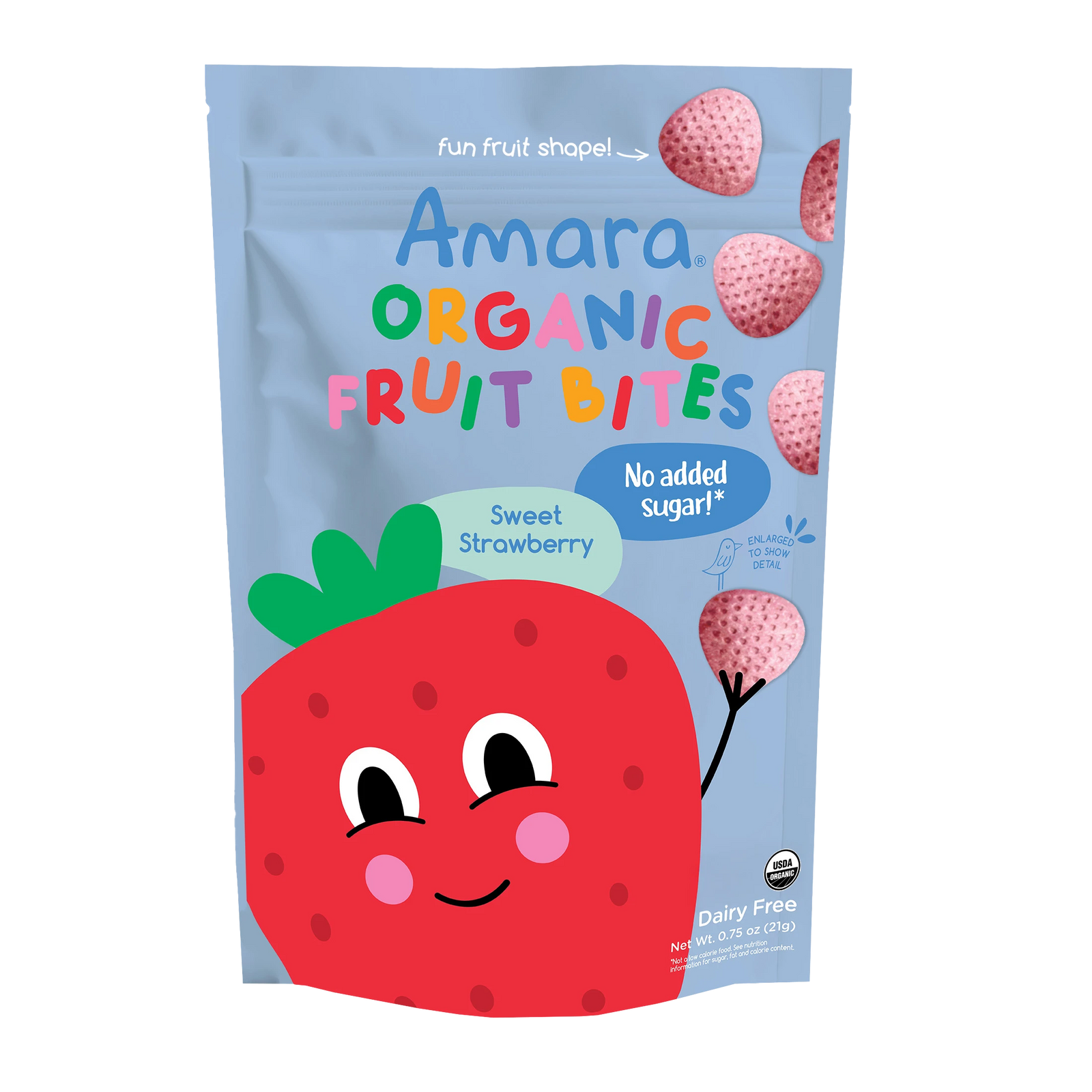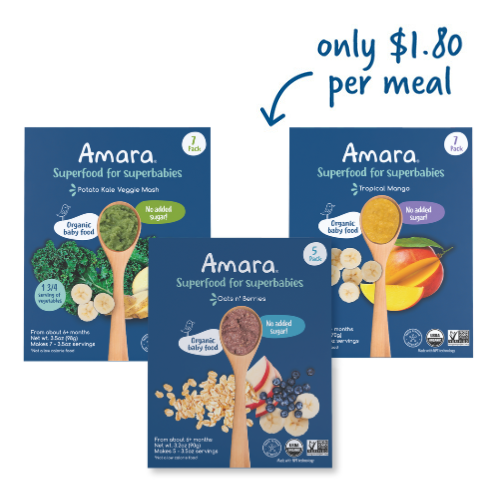A Deep Dive into Baby Rice Cereal
In America, the traditional first solid food for a baby has been rice cereal. It’s likely rice cereal was the first solid food for everyone up to your grandparent’s generation here! But what is it exactly, and might there be better choices? Some people are for rice cereal for babies, and some are against it. A popular alternative to rice cereal is oatmeal cereal for babies - check out Amara's Oats n Berries cereal if you're interested in a healthy alternative. Plus - Amara was voted the #1 Best Baby Food by The Bump - healthy, delicious and nutritious!
We want to leave the decision up to your child’s pediatrician, but we do want to give you the information for both sides of the argument so you can have an informed discussion with them about what to feed your growing baby during those critical first few months of solid food.
What is Rice Cereal?
Rice cereal is a commercially-made product designed to be gentle on a baby’s stomach and easy to prepare. It’s mixed with water or breast milk to create a thin porridge. Rice cereal usually contains the following ingredients:
- Rice flour
- Soy oil (lecithin)
- A calcium source (e.g. tricalcium phosphate) which also keeps the cereal from clumping
- Iron
- Additional vitamins depending on the brand
Rice cereal is cooked at the factory and then dehydrated so no cooking is required at home. This makes it very easy to prepare for a meal. Iron and vitamin fortification give it greater nutrition than plain rice flour, which is usually made from white rice. There are brown rice varieties available in organic health food stores that may have higher levels of nutrition.
Another benefit of rice cereal is that rice is the grain least likely to cause an allergic reaction in a baby, though it can cause gas.
When You Should Use Rice Cereal and How to Give it to Your Baby:
The consensus of many health organizations is that no solid foods should be introduced before six months of age. However, some pediatricians do recommend that solid foods can be introduced after four months of age. Four months is the minimum amount of time it takes for your baby’s digestive system to be able to handle solid food, so don’t give them rice cereal or any other solid food before then!
Another no-no is to feed a baby rice cereal with a bottle. This used to be a practice that was believed to fill babies faster, help them sleep more, and could reduce colic. But even Gerber isn’t recommending this practice anymore. It’s not only a choking hazard, but the calming effect is due to overfeeding. Putting rice cereal in a bottle is like giving a baby Thanksgiving dinner with each feeding!
Instead, after feeding, introduce them to rice cereal or another solid food, no more than two spoonfuls to start. Make sure that it is quite runny. As your baby gets used to moving food around in the mouth you can use less liquid. Increase the amount of pureed food slowly. Our guides on introducing babies to solid food can be a great help if you need some guidance.
Rice Cereal Controversy: Why Might Rice Cereal be Bad?
If rice cereal has been used as a healthy baby food for so long, why is there controversy about it today? Part of the controversy comes from giving it to babies too early, using too much, or putting it in bottles like we’ve already discussed. However, there is a new danger that is causing some parents to shy away from it.
First, there’s the naturalness factor. There’s no question that rice cereal is a processed food. That’s what makes it so soft for babies to eat and so easy to prepare. If it wasn’t enriched with vitamins and iron there would be little nutritional value beyond calories. But there are other grain-based foods that could be cooked to the same consistency with a little time, like baby oatmeal or Cream of Wheat. Additionally, fruit and vegetable based foods like Amara’s organic baby food could also serve as a good first solid food for a baby. Amara is designed to mix with breastmilk, formula or water for a gentle transition to solid foods.
Just use a little more water or breastmilk than you might otherwise to make it runny enough. As you transition your baby off of breastmilk, you’ll need to make sure that there’s a variety of foods to fulfill your baby’s nutritional needs. Don’t just rely on cereal! This is why rice cereal is fortified to ensure this happens, though there is a question about how much of the vitamins and minerals actually get absorbed compared to those in real food.
The big worry that’s going around the web is the presence of arsenic in rice. Don’t panic just yet, but here’s what you need to know. All plants absorb minerals from the soil to help them grow. Naturally-occurring arsenic minerals are also part of some soils. Rice is a plant that can use these compounds as part of its growth. This isn’t a huge problem; humans have been eating rice for thousands of years with no evidence of arsenic poisoning.
The danger comes when rice plants are mixed with agricultural and industrial runoff. These industries can create higher concentrations of arsenic in water. When the paddies are flooded, the rice can absorb this extra arsenic to potentially unsafe levels.
The FDA recommends that there be no more than 100 parts per billion of arsenic in rice to be considered safe. This is ten times the allowable amount in drinking water. A recent study found that many rice cereal companies are exceeding this recommended amount. There have been zero reports of deaths or emergency room visits from rice cereal, but arsenic has been shown to cause developmental issues in children in excessive amounts (e.g. industrial accidents or waste dumps.) The jury is still out on whether the amount of arsenic found in rice cereal these days is enough to cause problems.
Healthy Alternatives to Rice Cereal
Fortunately, there are a lot of alternatives to rice cereal like baby oatmeal and soft fruits and vegetables to start your baby off right eating solids.
Baby oatsare easy to make at home if you grind up oatmeal beforehand and then cook it well and serve while cool and runny.
Soft fruits like avocado are also good choices, and Amara’s introduction to solids baby food pouches give moms a lot of variety to choose from and mixing it with breastmilk and formula makes the transition to solids a smooth ride. As for iron, mothers who eat liver and other organ meats can build up enough iron to pass easily through breast milk to babies.
If you still prefer to use rice cereal, just make sure to follow the guidelines for when to use it and how to use it. Always of course, checking with your pediatrician ;)
Sources:
https://www.livestrong.com/article/247053-baby-rice-cereal-gas/
https://www.livestrong.com/article/205596-how-long-should-i-feed-my-baby-gerber-cereal-for-babies/
https://www.gerber.com/products/product/gerber-single-grain-cereal-rice
https://www.babycenter.com/404_is-it-safe-to-feed-my-baby-rice-cereal_10384011.bc







Leave A Comment